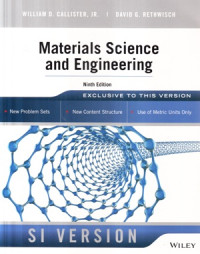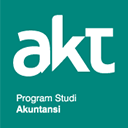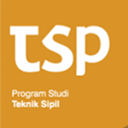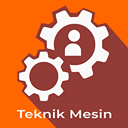Text
Materials science and engineering
I n this ninth edition we have retained the objectives and approaches for teaching materials science and engineering that were presented in previous editions. The first, and primary, objective is to present the basic fundamentals on a level appropriate for university/college students who have completed their freshmen calculus, chemistry, and physics courses.
The second objective is to present the subject matter in a logical order, from the simple to the more complex. Each chapter builds on the content of previous ones.
The third objective, or philosophy, that we strive to maintain throughout the text is that if a topic or concept is worth treating, then it is worth treating in sufficient detail and to the extent that students have the opportunity to fully understand it without having to consult other sources; in addition, in most cases, some practical relevance is provided.
The fourth objective is to include features in the book that will expedite the learning process. These learning aids include the following:
1. Numerous illustrations, now presented in full color, and photographs to help
visualize what is being presented
2. Learning objectives, to focus students' attention on what they should be getting
from each chapter
3. "Why Study ..." and "Materials of Importance" items as well as case studies that
provide relevance to topic discussions
4. "Concept Check" questions that test whether a student understands the subject
matter on a conceptual level
5. Key terms, and descriptions of key equations, highlighted in the margins for quick
reference
6. End-of-chapter questions and problems designed to progressively develop
students' understanding of concepts and facility with skills
7. Answers to selected problems, so students can check their work
8. A glossary, a global list of symbols, and references to facilitate understanding of the
subject matter
9. End-of-chapter summary tables of important equations and symbols used in these
equations
10. Processing/Structure/Properties/Performance correlations and summary concept
maps for four materials (steels, glass-ceramics, polymer fibers, and silicon
semiconductors), which integrate important concepts from chapter to chapter
11. Materials of Importance sections that lend relevance to topical coverage by
discussing familiar and interesting materials and their applications
The fifth objective is to enhance the teaching and learning process by using the newer tech¬nologies that are available to most instructors and today's engineering students.
Ketersediaan
Informasi Detail
- Judul Seri
-
-
- No. Panggil
-
620.11 Cal m
- Penerbit
- New Jersey : Wiley., 2015
- Deskripsi Fisik
-
xxiv, 908 hal. : il. ; 25 cm.
- Bahasa
-
English
- ISBN/ISSN
-
9781118319222
- Klasifikasi
-
620.11
- Tipe Isi
-
-
- Tipe Media
-
-
- Tipe Pembawa
-
-
- Edisi
-
Ed. IX
- Subjek
- Info Detail Spesifik
-
-
- Pernyataan Tanggungjawab
-
-
Versi lain/terkait
Tidak tersedia versi lain
Lampiran Berkas
Komentar
Anda harus masuk sebelum memberikan komentar

 Karya Umum
Karya Umum  Filsafat
Filsafat  Agama
Agama  Ilmu-ilmu Sosial
Ilmu-ilmu Sosial  Bahasa
Bahasa  Ilmu-ilmu Murni
Ilmu-ilmu Murni  Ilmu-ilmu Terapan
Ilmu-ilmu Terapan  Kesenian, Hiburan, dan Olahraga
Kesenian, Hiburan, dan Olahraga  Kesusastraan
Kesusastraan  Geografi dan Sejarah
Geografi dan Sejarah  Akuntansi
Akuntansi  Penelitian
Penelitian  Teknik Sipil
Teknik Sipil  Teknik Mesin
Teknik Mesin